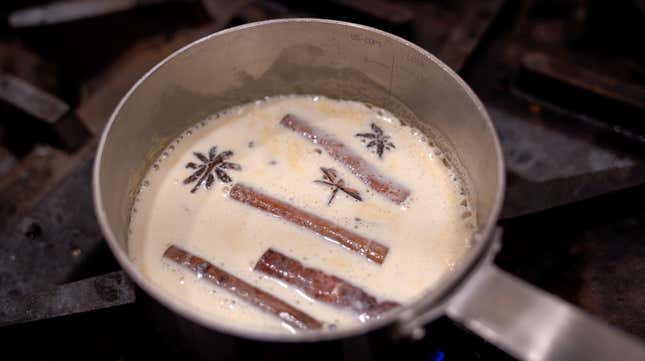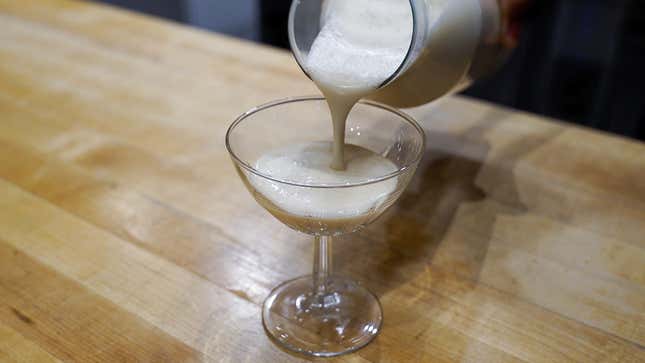
One of my favorite holiday traditions was sipping my grandmother’s New Orleans–style egg nog. It was rich and frothy, filled with heavy cream, eggs, and whiskey so strong that I wasn’t allowed to taste it until I was 18. I later learned that there were four kinds of liquor in the mix: whisky, brandy, rum, and amaretto, because New Orleans. This concoction was so thick that it could easily be consumed with a spoon. She steeped it for 30 days and the aroma of ginger and spirits floated through the house whenever she opened the refrigerator. I remember drinking a glass mug of this nog alongside her homemade rum cake; the lights were twinkling on the tree and my grandmother, great aunt, and uncle were laughing in the background. That memory encapsulates what the holidays mean to me, all its warmth and cinnamon-scented treats. When my grandmother passed away, her egg nog was one of the few recipes that I didn’t inherit (she never wrote down her recipes). So for years, I refused to drink egg nog. The sad store-bought versions were too bland, and all the homemade versions I tried never had the right kick.
Then I traveled to Puerto Rico one November. I had been there several times before, but I had never visited during what I came to learn was the extra-long Puerto Rican holiday season. La Navidad runs 45 days, from late November to mid-January, for the Fiestas de la Calle San Sebastian street festival. So when I arrived, lights and scenes of jibaritos and the three kings were already lining the streets of Caguas and San Juan. Thanks to Chicago’s notable Puerto Rican presence, I knew a lot of the local foods like pasteles (green plantain mixed with meat and stuffed in banana leaves) and arroz con gandules (rice and pigeon peas)—but I was focused on tasting the national dish, mofongo. The savory goodness of that hearty meal will be the subject of a future column, but my experience with mofongo ultimately introduced me to a Puerto Rican holiday essential.
I was in a small local diner in Caguas when, having stuffed myself silly with mofongo, the chef offered me a glass of coquito. I’m ashamed to say that I turned it down, mainly because he described it as Puerto Rican egg nog, and as I explained, me and egg nog were not on good terms. I did sample the traditional holiday dessert tembleque and loved the light flavor of the coconut pudding.
When I headed back to San Juan, my friend Santiago took me to a small cafe in Old San Juan. The tiny space was dripping with tinsel and lights and locals were snacking on tostones or eating big bowls of bacalao guisado (codfish stew). Everyone also seemed to be drinking coquito and when I explained my problem with egg nog, Santiago rolled his eyes. “Coquito is not like that yanqui egg nog, trust me,” he said. So after we ate the tasty bacalao brimming with sofrito and green peppers, I ordered a glass. The small serving inferred that the creamy drink was made for sipping, but I quickly downed it in delight. The taste of coconut and cinnamon swirled with rum on my tongue. I ordered another and indignantly asked Santiago why he hadn’t told me that coquito was basically a spiced pina colada without the pineapple. Which is to say, like anything made from coconut, it’s pure heaven. Since that day, coquito has been my go-to holiday drink. I prefer the coconut cream and milk to the eggs in egg nog, and it reminds me of Puerto Rico’s nonstop festive energy.
“Coquito is traditionally served during the holiday season, but the ingredients are easy to find all year round,” says Jessica van Dopp DeJesus, founder and editor of The Dining Traveler and author of The Dining Traveler Guide to Puerto Rico. The book is a love letter to the island and a showcase for Boricua cuisine, of which coquito is a highlight.
“Coquito is a big part of our family’s holiday tradition,” DeJesus explains. “My parents owned a liquor store, so my mom used to experiment with different rums and coquito. Since I can remember, there’s always been a bottle of coquito in the refrigerator for guests. When we moved to Puerto Rico, we used to get ‘parrandas,’ groups of friends and family that show up to your home late at night with live music to celebrate the holidays. I kept my family tradition of making coquito as it makes me feel closer to home. Since parrandas are not as common, I like to make small bottles of coquito and gift them to neighbors, clients, and friends.”
I also make bottles of coquito now, and I’m working on saving some to pass along to friends as gifts this year. Below is Jessica’s recipe for coquito; you can also watch her prepare it in this YouTube video.

Coquito
- 1 (12-oz.) can evaporated milk
- 1 inch fresh ginger, thinly sliced
- 3 cinnamon sticks
- 1 tsp. whole cloves
- 1-2 star anise pods (optional)
- 1 (13.5-oz.) can unsweetened coconut milk
- 1 (14-oz.) can sweetened condensed milk
- 1 (15-oz.) can cream of coconut milk
- 1 1/2 cups rum (Ron del Barrilito is what’s used in the video above; if you don’t consume alcohol, you can skip this ingredient)
- ground cinnamon for garnish
In a small saucepan, pour the entire contents of the evaporated milk. Add ginger, cinnamon, and cloves. Bring to a quick boil and then simmer for 3 minutes. Let it cool to room temperature with the spices still inside.
Pour the evaporated milk mixture through a fine sieve. Set the cinnamon sticks aside.
Mix evaporated milk and the rest of the ingredients in the blender. Blend at medium speed until well blended. Pour into a glass bottle (great way to repurpose your rum bottles) and toss a cinnamon stick in the bottle to add more spice flavor.
Let the mixture chill, ideally overnight, for the flavors to come together. Serve cold with a sprinkle of cinnamon. ¡Salud!